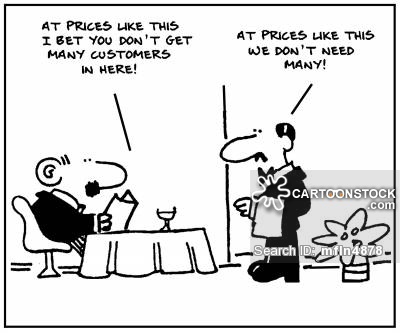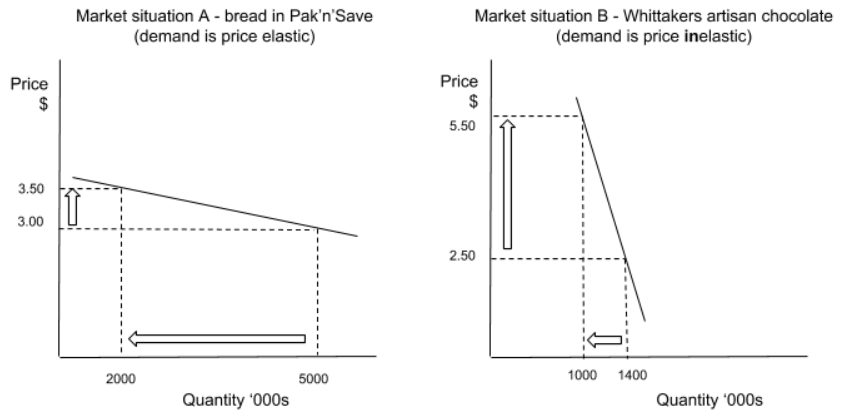Term 2 Weeks1&2 (15-26 April)
Section outline
-
Learning Intentions

- Investigate ways in which businesses can price their products
- Explore examples of different pricing strategies and reasons for using each strategy.
- Explore the specific effect of changes in price on quantity sold and thus on profit.
- Can describe several key strategies for pricing products
- Can predict the effect of a price change on sales and thus profits.
Price
The price of o product sends strong messages to consumers. Would you buy a parachute in a sale at half price, or a perfume, for a valued friend, that was advertised as being low price, or petrol at a much higher price than competitors' prices?
Pricing strategies
- Cost-plus pricing - adding a percentage markup to the estimated unit cost.
- Penetration pricing - initial low price to encourage customers to try the product (but could send the message of low quality).
- Skimming - high price until competition forces it down
- Competitive pricing - in line with, or a certain percentage above, competitors' prices.
- Psychological pricing - appears closer to customer's perceived value (eg $3.99)
- Prestige price - to promote a luxury image (eg perfume)
- Price discrimination - price for the same product varies for different customer groups (eg students, off-peak travel).
- Loss leader - very low price attracts customers into the shop to buy other products at 'normal' prices.
- Promotional pricing - low price for a short time to renew customer interest or clear unwanted stock.
- Range pricing - prices of similar types of product kept within limits.
In your group, discuss which price strategy is being used in each of the examples below:
- A watch that’s very similar to others sold in the shops
- A toy sold for $1.95
- A tour operator sells holidays during the school holidays as well as at other times.
- A new brand of washing powder is launched - there are several similar ones already available
- A supermarket wants to cover the cost of vegetables and make a 100% profit as well.
- A new mobile phone has been developed that has extra features compared to the competition.
Price Elasticity of Demand (PED)
PED is a measure of the responsiveness of demand of a product to a change in its price (ie how much quantity sold will change if you change price).

Market for bread: A small increase in price causes a large decrease in quantity sold
Market for Whittakers chocolate: A large increase in price causes a small decrease in quantity sold.
This is important because any change in price affects your total income.
Consider whether, in order to increase total income, we should i) increase the price of bread OR increase the price of Whittakers chocolate.
Using the equation Price X Quantity = Total Income, calculate the income earned before and after each price change:Income from bread sales before the change: $3 x 5000 = $15,000. Income from bread sales after the change: $3.50 x 2,000 = $7,000. Even though we are receiving more money from each loaf, our total income from selling bread has decreased.
Income from chocolate sales before the change: $2.50 x 1400 = $3,500. Income from bread sales after the change: $5.50 x 1000 = $5,500. We are receiving more money from each loaf, AND our total income from selling bread has increased.
It makes sense, in this example, for us to increase prices of Whittakers chocolate, but not of bread.
Calculating Price Elasticity of Demand
It's possible to calculate a number (called the Coefficient of Elasticity) that represents the price elasticity of demand for a product. This enables us to predict the effect of a price change. There are 2 methods: percentage method and mid-point method.
Percentage method uses % change in quantity which is (change in quantity / original quantity) x 100
% change in price (change in price / original price) x 100For bread: -(5000 - 2000) / 5000 x 100 = -0.6 x 100 = -60 = -3.53 (larger than 1 and so demand is price elastic)
(3.50-3.00) / 3.00 x 100 0.17 x 100 17For chocolate: -(1400 - 1000) / 1400 x 100 = -0.29 x 100 = -29 = -0.24 (< 1 and so demand is price inelastic)
(5.50-2.50) / 2.50 x 100 1.2 x 100 120NB: Both coefficients are negative. This shows that price and quantity have a negative relationship - as one goes up, the other goes down.
Mid-point method also uses % change in quantity BUT this is (change in quantity / average quantity) x 100
% change in price (change in price / average price) x 100For bread: -(5000 - 2000) / 3500 x 100 = -0.86 x 100 = -86 = -5.7 (larger than 1 and so demand is price elastic)
(3.50-3.00) / 3.25 x 100 0.15 x 100 15For chocolate: -(1400 - 1000) / 1200 x 100 = -0.33 x 100 = -33 = -0.44 (smaller than 1 and so demand is price inelastic)
(5.50-2.50) / 4.00 x 100 0.75 x 100 75Which method should I use?
Use the Mid-point method because it calculates the same answer whether the price and quantity are increasing or decreasing.
If you don't believe this, re-calculate the price elasticity of bread and Whittakers chocolate, but this time decrease the price between the same points (ie change the arrow directions). Do this using first the percentage method and then the mid-point method.
Answers: Did you calculate figures of -10.7 and -0.74 using the Percentage Method? Did you find no change using the Mid-Point Method?
In your group, consider what types of product might have a price inelastic demand and which might have a price elastic demand.Extension reading
If pricing and consumer psychology interest you, this online article provides an interesting insight into the science behind pricing and purchasing decisions.
